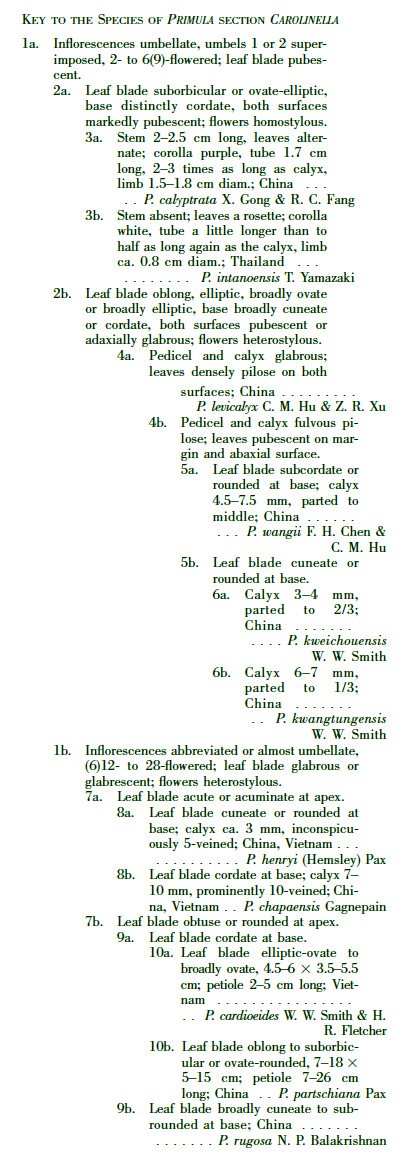Where it began,
I can't begin to knowin'
But then I know it's growing strong
Was in the spring
And spring became the summer
Who'd have believed you'd come along
... Sweet Caroline.*
I can't begin to knowin'
But then I know it's growing strong
Was in the spring
And spring became the summer
Who'd have believed you'd come along
... Sweet Caroline.*
 |
| Primula cardioeides in Vietnam |
In 1891, Augustine Henry married Caroline Orridge, though their marriage lasted only three years due to Caroline's tragic death from tuberculosis. Henry's job as a Customs officer lead him to Mengzi (modern Honghe) in southeastern Yunnan. By this time he was well established in plant collecting and his collection Henry 10735 from the forests SE of Mengzi was described as Carolinella henryi, named for his late wife. Though it was thought to be a new Genus, Pax later included it within Primula as section Carolinella and the species became Primula henryi. Unfortunately this name had already been used, so it was given the new name "Primula carolinehenryi" by S.O'Brien in the book "In the Footsteps of Augustine Henry". This name has since been corrected according to the International Code of Nomenclature to "Primula carolinehenryae" as it honors a women.
 |
| Primula carolinehenryae E00255693 courtesy Royal Botanic Garden Edinburgh |
Two additional Henry collections were described from the area around Mengzi under the genus Carolinella: C. cordifolia (now P. partschiana) and C. obovata (now P. rugosa). The distinguishing feature of section Carolinella is the calyptrate capsule (the capsules don't split into 5 valves as most other species do, or by crumbling, but rather have a lid which lifts to expose the seeds). Some authorities recognise subgenus Carolinella which includes this section. The species in the section are distributed in SE Yunnan, S Guizhou, N Guangxi, S Hunan, N Guangdong, and N Vietnam.
In 2000 the paper "Pollen morphology in Primula sect. Carolinella (Primulaceae) and its taxonomic implications" was published, with SEM images of 7 species. It was found that there was considerable variation in the pollen morphology encompassing all 3 main pollen types (tricolpate, trisyncolpate and polycolpate) of the genus Primula and that this indicated that the group was heterogeneous.
 |
| P. rugosa, P. kweichouensis, P. wangii from Flora of China |
 |
| Primula cardioeides pollen From Pollen morphology in Primula sect. Carolinella (Primulaceae) and its taxonomic implications |
In 2010 the paper "Circumscription of Primula subgenus Auganthus (Primulaceae) based on chloroplast DNA sequences" was published. The result of this study was that species assigned to subgenus Carolinella are dispersed among the species of subgenus Auganthus and that as defined, neither subgenus is monophyletic and it is inferred that the calyptrate capsule has evolved multiple times in the genus Primula. Also P. wangii which was initially placed in section Carolinella, but subsequently placed by Richards into section Monocarpicae, has an ambiguous position.
In 2015 the paper "Non-monophyly of Primula subgenera Auganthus and Carolinella (Primulaceae) as confirmed by the nuclear DNA sequence variation" was published and it is similar to the 2010 study. It was concluded that the calyptrate capsule has evolved independently at least four times in Primula. P. wangii was found to be close to P. kwangtungensis and P. kweichouensis and so together with P. levicalyx (not sampled) this seems to be a distinct group within the section. In 2014, the species P. hunanensis was described and placed in this group and the following key was presented.
The species presently included in section Carolinella are: P. calyptrata, P. cardioeides, P. carolinehenryae, P. chapaensis, P. hunanensis, P. intanoensis, P. kwangtungensis, P. kweichouensis, P. levicalyx, P. partschiana, P. rugosa, and P. wangii. In future, we can expect that the section will be split to follow the results of genetic study. See the Species Gallery under each of these for more information.
Pam Eveleigh © 2016








0 comments :
Post a Comment